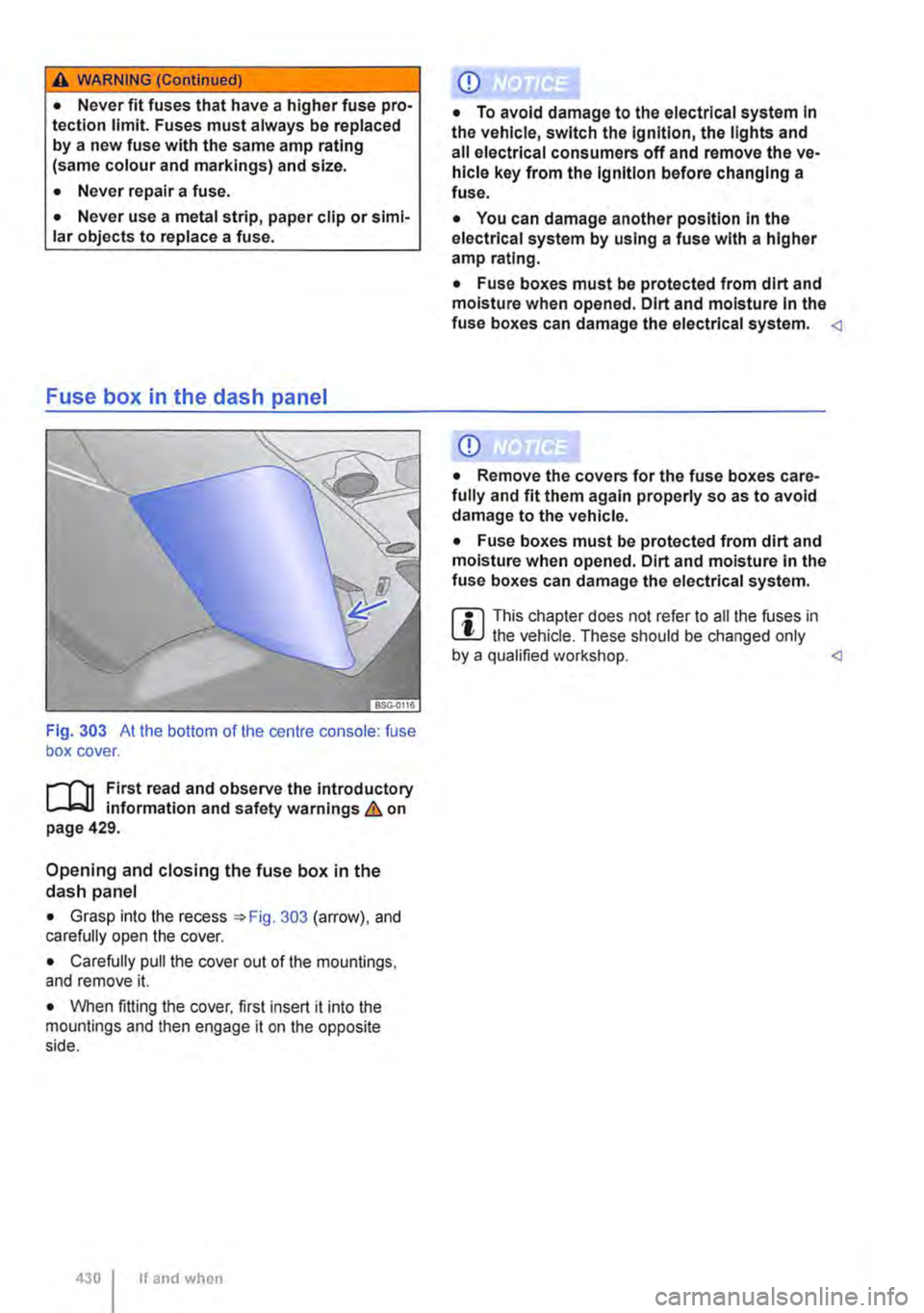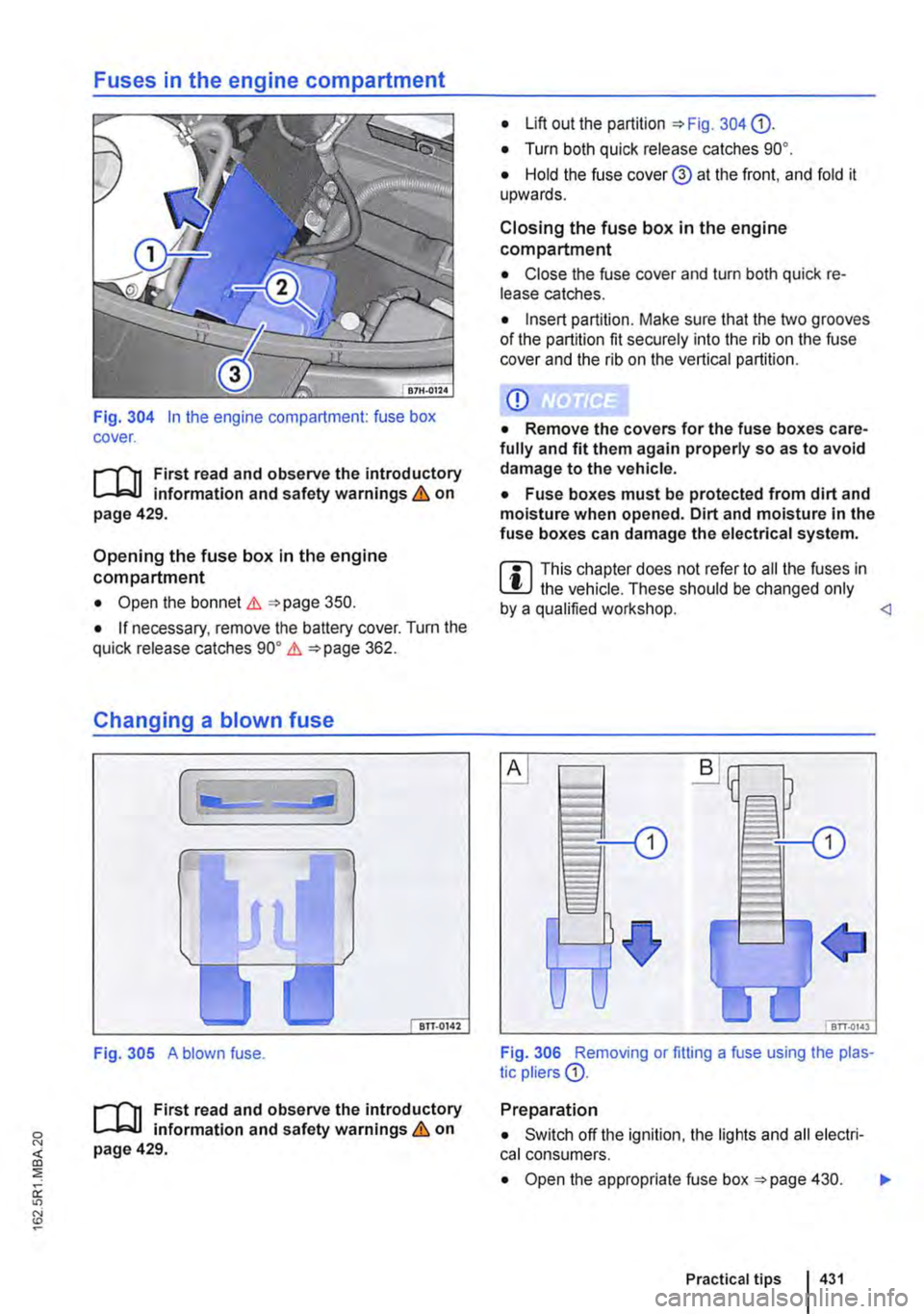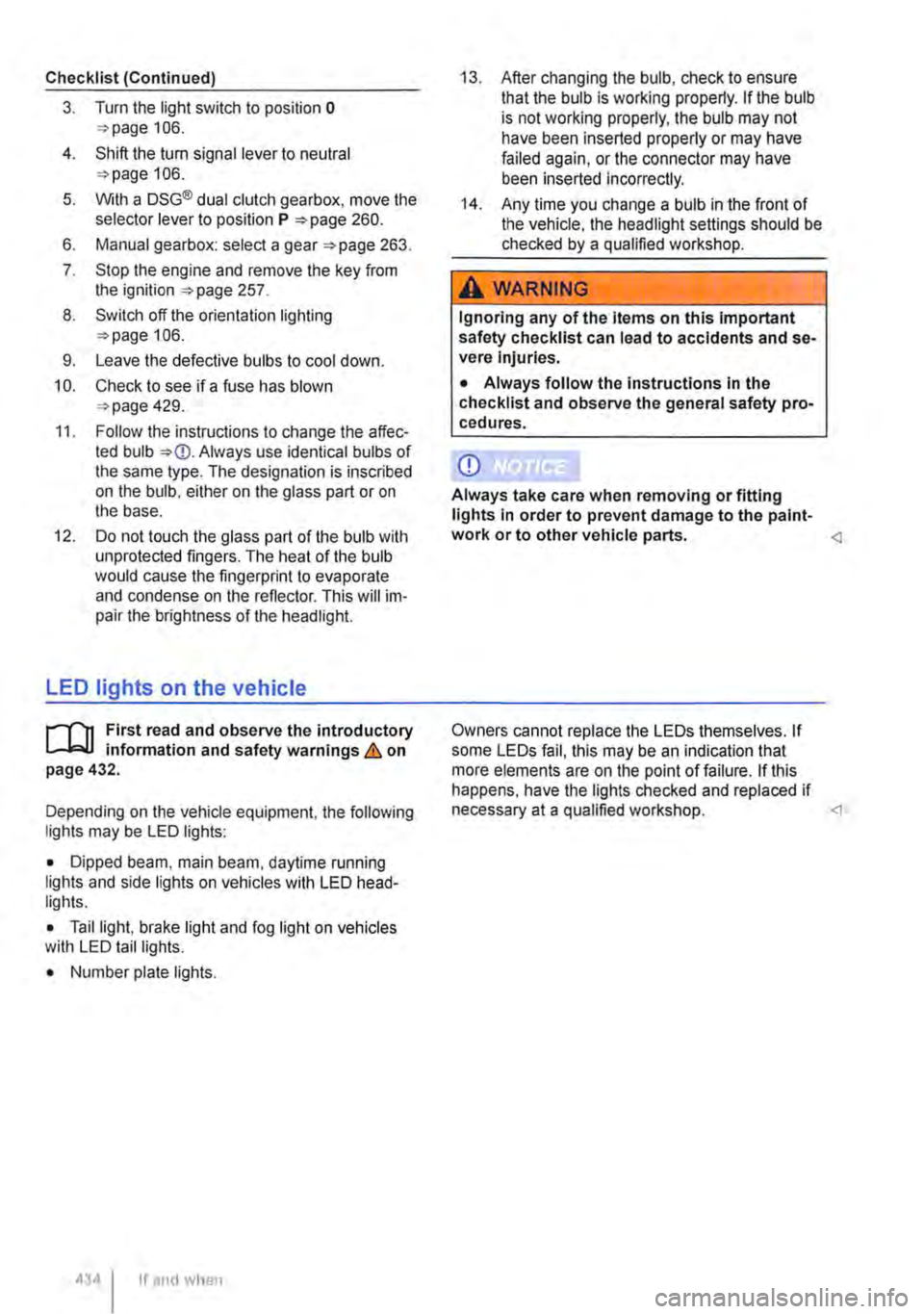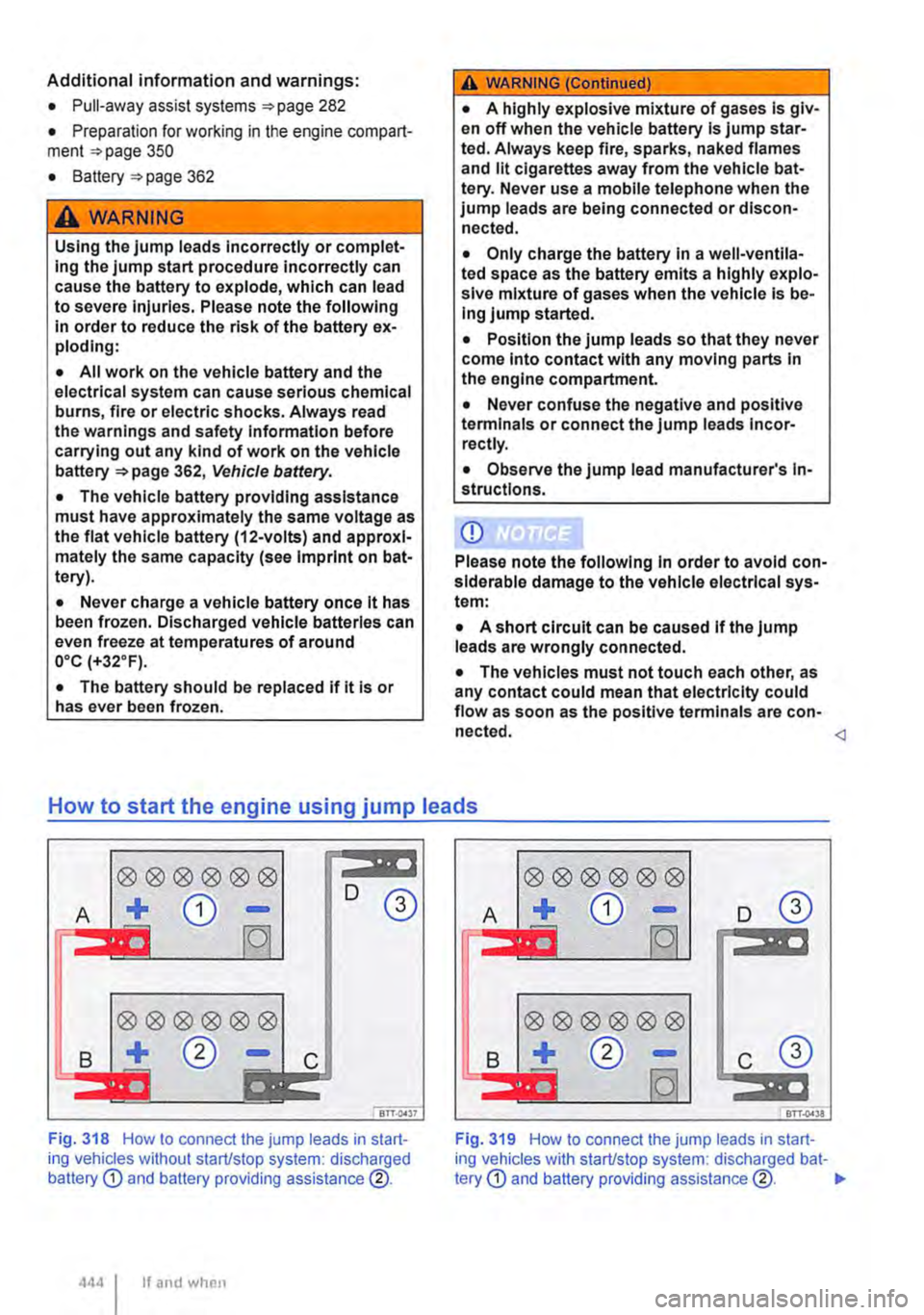2012 VOLKSWAGEN TRANSPORTER fuse
[x] Cancel search: fusePage 430 of 486

A WARNING (Continued)
• Never fit fuses that have a higher fuse pro-tection limit. Fuses must always be replaced by a new fuse with the same amp rating (same colour and markings) and size.
• Never repair a fuse.
• Never use a metal strip, paper clip or simi-lar objects to replace a fuse.
Fuse box in the dash panel
Fig. 303 At the bottom of the centre console: fuse box cover.
r-f"'n First read and observe the introductory information and safety warnings & on page 429.
Opening and closing the fuse box in the dash panel
• Grasp into the recess =>Fig. 303 (arrow), and carefully open the cover.
• Carefully pull the cover out of the mountings, and remove it.
• When fitting the cover. first insert it into the mountings and then engage it on the opposite side.
430 If and when
CD
• To avoid damage to the electrical system in the vehicle, switch the Ignition, the lights and all electrical consumers off and remove the ve-hicle key from the ignition before changing a fuse.
• You can damage another position In the electrical system by using a fuse with a higher amp rating.
• Fuse boxes must be protected from dirt and moisture when opened. Dirt and moisture In the fuse boxes can damage the electrical system. <1
CD
• Remove the covers for the fuse boxes care-fully and fit them again properly so as to avoid damage to the vehicle.
• Fuse boxes must be protected from dirt and moisture when opened. Dirt and moisture in the fuse boxes can damage the electrical system.
m This chapter does not refer to all the fuses in W the vehicle. These should be changed only by a qualified workshop. <1
Page 431 of 486

Fig. 304 In the engine compartment: fuse box cover.
;-('n First read and observe the introductory L-Jc.IJ information and safety warnings & on page 429.
Opening the fuse box in the engine compartment
• Open the bonnet .1. =<>page 350.
• If necessary, remove the battery cover. Turn the quick release catches go• .1. =<>page 362.
Changing a blown fuse
Fig. 305 A blown fuse.
;-('n First read and observe the introductory L-Jc.IJ information and safety warnings & on page 429.
• Lift out the partition =<>Fig. 304 0).
• Turn both quick release catches go•.
• Hold the fuse cover@ at the front. and fold it upwards.
Closing the fuse box in the engine compartment
• Close the fuse cover and turn both quick re-lease catches.
• Insert partition. Make sure that the two grooves of the partition fit securely into the rib on the fuse cover and the rib on the vertical partition.
CD
• Remove the covers for the fuse boxes care-fully and fit them again properly so as to avoid damage to the vehicle.
• Fuse boxes must be protected from dirt and moisture when opened. Dirt and moisture in the fuse boxes can damage the electrical system.
m This chapter does not refer to all the fuses in L!J the vehicle. These should be changed only by a qualified workshop.
Preparation
• Switch off the ignition, the lights and all electri-cal consumers.
• Open the appropriate fuse box =<>page 430. .,..
Practical tips I 431
Page 432 of 486

Detecting a blown fuse
If the metal strip is melted this indicates that the fuse has blown 305.
Shine a torch onto the fuse. This will help you to spot the blown fuse more easily.
Changing a fuse
• If applicable, take the plastic pliers 306 G) out of the fuse box cover.
• For small fuses. push the catch on G) from above 306
• For larger fuses, push the catch G) onto the fuse from the side 306@
Changing bulbs
o::n Introduction
This chapter contains information on the following subjects:
Indicator lamp . . . . . . . . . . . . . . . . . . . . . . . . . 433
Information on changing bulbs . 433 LED lights on the vehicle . . . . . . . . . 434
Changing bulbs in H4 halogen headlights 435
Changing bulbs in H7 halogen headlights . . . 437
Changing bulbs in the LED headlights . . . 438
Changing the bulbs in the fog light . . . . . . . . . 439 Changing the bulbs in the tail light cluster on vehicles with tailgate . . . . . . . . . . . . . . . . . . . . . 440
Changing the bulbs in the tail light cluster on vehicles with wing doors .................. 441
Changing the bulbs in the LED tail light cluster . . . . . . . . . . . . . . . . . . . . . . . . . 442 Changing the side turn signal bulbs . . . . . . . . 443
Changing the vehicle bulbs requires considerable technical skill. Therefore if you do not feel confi-dent with the procedure. Volkswagen Commercial Vehicles recommends having the bulbs changed by a Volkswagen Commercial Vehicles dealership or other professional assistance. You must contact a qualified workshop if other vehicle parts around the lights need to be removed or LED lights need to be replaced.
You should keep a box with spare light bulbs for the lights that ensure the vehicle is roadworthy in the vehicle at all times. Spare bulbs are available from Volkswagen Commercial Vehicles dealers. In some countries it is a legal requirement to have these spare bulbs in the vehicle.
lt may be illegal to drive with a defective bulb in the exterior lighting.
4321 If and when
• Pull out the blown fuse.
• If the fuse has blown, replace it with a new fuse of the same amp rating (same colour and same markings) and same size
• Replace the cover.
CD
You can damage another position In the electri-cal system by using a fuse with a higher amp rating.
You can change the following bulbs yourself:
• Bulbs of the halogen headlights.
• Turn signal bulb in the LED headlights.
• Bulbs in non-LED tail light cluster.
• Turn signal and reversing light bulb in the LED tail light cluster.
• Bulb of turn signal repeater.
• Bulb of fog lights.
All LED lights in the vehicle should always be changed by an expert.
Additional bulb specifications
Some bulbs in headlights or In tail light clusters might have factory specifications that are different to standard bulbs. The designation is inscribed on the bulb, either on the glass part or on the base.
Additional information and warnings:
• Exterior views 5
• Lights and vision 106
• Preparation for working In the engine compart-ment 350
• Vehicle toolkit 416
• Fuses 429
A WARNING
Accidents can occur If roads are not suffi-ciently Illuminated and other road users have difficulty seeing the vehicle, or cannot see it atall. 11>
Page 434 of 486

Checklist (Continued)
3. Turn the light switch to position o 106.
4. Shift the tu m signal lever to neutral 106.
5. With a DSG® dual clutch gearbox, move the selector lever to position P 260.
6. Manual gearbox: select a gear 263.
7. Stop the engine and remove the key from the ignition 257.
8. Switch off the orientation lighting 106.
9. Leave the defective bulbs to cool down.
10. Check to see if a fuse has blown 429.
11. Follow the instructions to change the affec-ted bulb Always use identical bulbs of the same type. The designation is inscribed on the bulb, either on the glass part or on the base.
12. Do not touch the glass part of the bulb with unprotected fingers. The heat of the bulb would cause the fingerprint to evaporate and condense on the renector. This will im-pair the brightness of the headlight.
LED lights on the vehicle
r--f'n First read and observe the introductory L-I=J.I information and safety warnings & on page 432.
Depending on the vehicle equipment, the following lights may be LED lights:
• Dipped beam, main beam, daytime running lights and side lights on vehicles with LED head-lights.
• Tail light, brake light and fog light on vehicles with LED tail lights.
• Number plate lights.
434 If and when
13. After changing the bulb, check to ensure that the bulb is working properly. If the bulb is not working properly, the bulb may not have been inserted properly or may have failed again, or the connector may have been inserted incorrectly.
14. Any time you change a bulb in the front of the vehicle, the headlight settings should be checked by a qualified workshop.
A WARNING
Ignoring any of the items on this important safety checklist can lead to accidents and se-vere Injuries.
• Always follow the instructions in the checklist and observe the general safety pro-cedures.
CD
Always take care when removing or fitting lights in order to prevent damage to the paint-work or to other vehicle parts. <1
Owners cannot replace the LEDs themselves. If some LEDs fail, this may be an indication that more elements are on the point of failure. If this happens, have the lights checked and replaced if necessary at a qualified workshop.
Page 444 of 486

Additional information and warnings:
• Pull-away assist systems 282
• Preparation for working in the engine compart-ment 350
• Battery 362
A WARNING
Using the jump leads Incorrectly or complet-ing the jump start procedure incorrectly can cause the battery to explode, which can lead to severe Injuries. Please note the following In order to reduce the risk of the battery ex-ploding:
• All work on the vehicle battery and the electrical system can cause serious chemical burns, fire or electric shocks. Always read the warnings and safety Information before carrying out any kind of work on the vehicle battery 362, Vehicle battery.
• The vehicle battery providing assistance must have approximately the same voltage as the flat vehicle battery (12-volts) and approxi-mately the same capacity (see Imprint on bat-tery).
• Never charge a vehicle battery once it has been frozen. Discharged vehicle batteries can even freeze at temperatures of around o•c (+32"F).
• The battery should be replaced if it is or has ever been frozen.
A WARNING (Continued)
• A highly explosive mixture of gases Is giv-en off when the vehicle battery Is jump star-ted. Always keep fire, sparks, naked flames and lit cigarettes away from the vehicle bat-tery. Never use a mobile telephone when the jump leads are being connected or discon-nected.
• Only charge the battery in a well-ventila-ted space as the battery emits a highly explo-sive mixture of gases when the vehicle Is be-Ing jump started.
• Position the jump leads so that they never come Into contact with any moving parts In the engine compartment.
• Never confuse the negative and positive terminals or connect the jump leads Incor-rectly.
• Observe the jump lead manufacturer's In-structions.
CD
Please note the following In order to avoid con-siderable damage to the vehicle electrical sys-tem:
• A short circuit can be caused If the jump leads are wrongly connected.
• The vehicles must not touch each other, as any contact could mean that electricity could flow as soon as the positive terminals are con-nected.
00®00® :liOIIr 11
D
A + CD -®
fOl
0®®®®®
B + 0 -c 11'"1111
! 8TT.QA37
Fig. 318 How to connect the jump leads in start-ing vehicles without start/stop system: discharged battery
B c
Fig. 319 How to connect the jump leads in start-ing vehicles with start/stop system: discharged bat-tery
Page 472 of 486

F
Factory plate . . . . . . . . . . . . . . . . . . . . . . . . 451
FAQs . . . . . . . . . . . . . . . . . . . . . . . . . . . . . . . 410
Fastening rings . . . . . . . . . . . . . . . . . . • . . . 134
Fault 230-volt Euro socket . . . . . . . . . . . . . . . . 246 Adaptive chassis control . . . . . . . . . 317, 318 Adaptive cruise control (ACC) . . . . . . . . . 299 Air conditioning system . . . . . . . . . . . . . . 328 Area monitoring system . . . . . . . . . . • . . . 308 Catalytic converter . . . . . . . . . . . . . . . . . . 408 Diesel particulate filter . . . . . . . . . . . . . . . 408 Driver Alert System .. .. .. .. .. . .. . .. . 316 DSG dual clutch gearbox . . . . . . . . . . . . . 267 Electric exterior mirrors . . . . . . . . . . . . . . 124 Electric windows . . . . . . . . . . . . . . . . . . . . 57 Front Assist .. .. .. .. .. .. .. .. .. .. .. . 308 Immobilizer . . . . . . . . . . . . . . . . . . . . . . . . 257 Lane change assist system (Side Assist) 313 Main beam assist . . . . . . . . . . . . . . . . . . . . 111 ParkPilot . . . . . . . . . . . . . . . . . . . . . . 288, 289 Radio reception . . . . . . . . . . . . . . . . . . . . 406 Rain sensor . . . . . . . . . . . . . . . . . . . • . . . 120 Sliding/tilting roof . . . . . . . . . . . . . . . . . . . . 59 Towing bracket . . . . . . . . . . . . . . . . . • . . . 145
Fault finding . . . . . . . • . . • . . • . . . . . . . . . . . 410
Fault memory . . . . . . . . . . . . . . . . . . . . . . . . 399
Filling the tank . . . . . . . . . . . . . . . . . . . . . . . 340 At the filling station . . . . . . . . . . . . . . . . . . 340 Checks when filling the tank . . . . . . . . . . 343 Diesel ............................ 342 Fuel ...........•................. 342 Fuel gauge . . . . . . . . . . . . • . . . . . . . . . . . 341 Indicator lamp ......... , . . . . . . . . . . . 341 Petrol . . . . . . . . . . . . . • . . . . . . . . • . . . . . 342
Filling up Incorrect fuel . . . . . . . • . . . . . . . . • . . . . . 341
Filter preheater .......... , . . . . . . . . . . . 345
Fire extinguisher . . . . . . . . . • . . • . . • . . • . . 413 Trailer . . . . . . . . . . . . . . . . • . . . . . . . . . . . 142
First aid kit . . . . . . . . . . . • . . . . . . . . . . . . . . 413 Stowage location . . . . . . . . . . . . . • . . • . . 413
First user pairing Rear-seat telephony.. . . . . . . . . . . . . . . . 190
Flyscreen element Sliding window . . . . . . . . . . • . . . . . . . . . . 232
Fog lights . . . . . . . . . . . . . . . . . . . . . . . . . . . 109
Folding out the table 3-seat bench . . . . . . . . . . . . . . . . . . . . . . . 74 Single seats in the passenger compartment .7.3
Folding table in the side panel . . . . . . . . . . 155 Assembling . . . . . . . . . . . . . . . . . . . . . . . 156 Stowed ........................... 156 Stowing . . . . . . . . . . . . . . . • . . . . . . . . . . 156
4721 tnllex
Folding table in the sliding door . . . . . . . . 229 Assembling . . . . . . . . . . . . . . . . . . . . . . . 229
Foot mats . . . . . . . . . • . . • . . . . . . . . . . . . . . 262
Footwelllight . . . . . . . . . . . . . . . . . . . . . . . . . 31
Four-wheel drive Snow chains . . . . . . . . . . . . . . . . . . . . . . . 379 Towing . . . . . . . . . . . . . . . . . . . . . . . . . . . 447 Winter tyres . . . . . . . . . . . . . . . . . . . . . . . 378
Frequently asked questions . . . . . . . . . . . . 410
Fresh water system . . . . . . . . . . . . . . . . . . . 238 Cleaning . . . . . . . . . . . . . . . . . . . . . . . • . . 239
Front airbags see Alrbag system . . . . . . . . . . . . . . . . . . . 92
Frontal collisions and the laws of physics . 81
Front Assist City Emergency Brake function ......... 311 Displays . . . . . . . . . . . . . . . . . . . . . . . . . . 308 Fault . . . . . . . . . . . . . . . . . . . . . . . . . . . . . 308 Radar sensor . . . . . . . . . . . . . . . . . . . . . . 309 see Area monitoring system (Front Assist) .307 System limits . . . . . . . . . . . . . . . . . . . . . . 312
Front passenger front airbag see Airbag system . . . . . . . . . . . . . . . • . . . 87 Switching off with the key switch . . . . . . . . 93
Front scan system Swnching off temporarily . . . . • . . . • . • . . 310
Front seats Turning . . . . . . • . . . . . . . . . . . . . . . . . . . . . 71
Fuel . . . . . . . . . . . . . . . . . . . . • . . • . . . . . • . . 343 Diesel ............................ 345 Petrol . . . . . . . . . . . . . . . . . . . . . . . . . • . . 344
Fuel consumption Driving economically . . . . . . . . . . . . . . . . 278 What increases it? . . . . . . . . . . . . . . . . . . 408
Fuel gauge . . . . . . . . . . . . . . . . . . . . . . . . . . 341 Indicator lamp . . . . . . . . . . . . . . . . . . . . . 341
Fuses . . . . . . . . . . . . . . . . . . . . . . . . . . . . . . 429
G
Camping equipment . . . . . . . . . . . . . . . . . 249 Changing . . . . . . . . . . . . . . . . . . . . . . . . . 431 Detecting a blown fuse . . . . . . . . . . . . . . . 432 Fuse box in engine compartment . . . . . . . 431 Fuse box in the dash panel . . . . . . . . . . . 430 Preparation for changing . . . . . . . . . . . . . 431
G 12 plus . . . . . . . . . . . . . . . . . . . . . . . . . . . 360
G 12 plus-plus . . . . . . . . . . . . . . . . . . . . . . . 360
G 13 ................................ 360 Gas bottle Changing . . . . . • . . . . . • . . . . . . . . . . . . . 235 Connecting . . . . . . . . . . . . . . . . . . . . . . . . 235
Gas cooker Cleaning . . . . . . • . . . . . • . . . . . . . . . . . . . 253 Turning off . . . . . . . . . . . . . . . . . . . . . . . . 236 Turning on . . . . . . . . . . . . . . . . . . . . . . . . 236